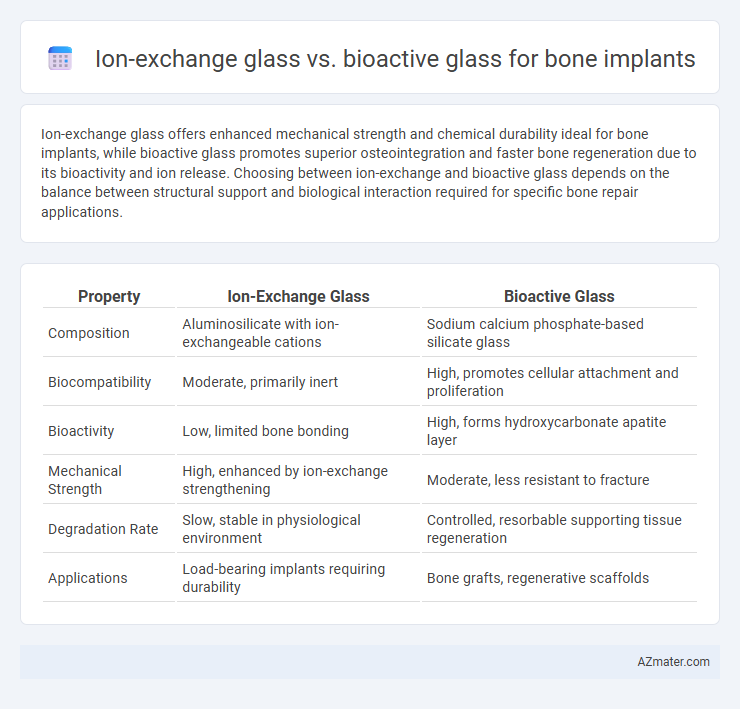Ion-exchange glass offers enhanced mechanical strength and chemical durability ideal for bone implants, while bioactive glass promotes superior osteointegration and faster bone regeneration due to its bioactivity and ion release. Choosing between ion-exchange and bioactive glass depends on the balance between structural support and biological interaction required for specific bone repair applications.
Table of Comparison
| Property | Ion-Exchange Glass | Bioactive Glass |
|---|---|---|
| Composition | Aluminosilicate with ion-exchangeable cations | Sodium calcium phosphate-based silicate glass |
| Biocompatibility | Moderate, primarily inert | High, promotes cellular attachment and proliferation |
| Bioactivity | Low, limited bone bonding | High, forms hydroxycarbonate apatite layer |
| Mechanical Strength | High, enhanced by ion-exchange strengthening | Moderate, less resistant to fracture |
| Degradation Rate | Slow, stable in physiological environment | Controlled, resorbable supporting tissue regeneration |
| Applications | Load-bearing implants requiring durability | Bone grafts, regenerative scaffolds |
Introduction to Bone Implant Materials
Ion-exchange glass and bioactive glass serve distinct roles in bone implant materials due to their differing compositions and properties. Ion-exchange glass enhances surface durability and chemical stability through controlled ion substitution, improving resistance to corrosion and wear. Bioactive glass, rich in silicon, calcium, and phosphate, actively bonds with bone tissue by forming hydroxycarbonate apatite layers, promoting osteointegration and accelerating bone regeneration.
Overview of Ion-Exchange Glass
Ion-exchange glass is a type of bioactive glass specifically engineered through ion-exchange processes to enhance its mechanical strength and chemical durability, making it highly suitable for bone implant applications. This glass undergoes surface modification by replacing smaller ions in the glass matrix with larger ones, which improves its resistance to cracking and wear while maintaining excellent biocompatibility and bone-bonding capabilities. In comparison to conventional bioactive glass, ion-exchange glass offers superior structural stability and controlled ion release, promoting faster bone regeneration and integration.
Overview of Bioactive Glass
Bioactive glass is a highly osteoconductive and osteoinductive biomaterial widely used in bone implants due to its unique ability to bond directly with bone tissue through the formation of a hydroxycarbonate apatite (HCA) layer. Its bioactivity promotes rapid mineralization and supports cellular responses critical for bone regeneration, distinguishing it from ion-exchange glasses whose primary function is surface ion release for localized therapeutic effects. The chemical composition of bioactive glass, often containing silica, calcium, phosphate, and sodium oxides, enables controlled degradation rates and ion release that stimulate osteogenesis and angiogenesis, enhancing implant integration and long-term stability.
Mechanisms of Bone Integration
Ion-exchange glass enhances bone integration through surface modification that increases chemical durability and creates a bioactive layer promoting hydroxyapatite formation, facilitating strong bonding with bone tissue. Bioactive glass releases biologically active ions such as calcium and silicon, stimulating cellular responses that accelerate osteogenesis and direct bone regeneration at the implant site. The ion-exchange mechanism primarily improves implant surface stability, whereas bioactive glass actively triggers biochemical pathways crucial for rapid and robust bone remodeling.
Biocompatibility of Ion-Exchange Glass
Ion-exchange glass exhibits superior biocompatibility for bone implants by promoting enhanced cellular adhesion and proliferation due to its controlled ion release, which stimulates osteogenic activity. Unlike bioactive glass, ion-exchange glass offers improved chemical durability and reduced cytotoxicity, minimizing inflammatory responses during implantation. Its tailored surface properties facilitate integration with bone tissue, making it a promising material for long-term bone regeneration applications.
Biocompatibility of Bioactive Glass
Bioactive glass exhibits superior biocompatibility compared to ion-exchange glass, promoting enhanced osteointegration and stimulating bone cell proliferation due to its ability to form a hydroxycarbonate apatite (HCA) layer that mimics natural bone mineral. Its chemical composition, rich in silica, calcium, and phosphate ions, facilitates strong bonding with bone tissue and supports the regeneration process without eliciting adverse immune responses. In contrast, ion-exchange glass primarily improves mechanical properties but lacks the intrinsic bioactivity necessary for effective bone remodeling and cellular interaction.
Mechanical Properties Comparison
Ion-exchange glass exhibits superior mechanical strength and hardness due to surface ion replacement that enhances durability and wear resistance, making it suitable for load-bearing bone implants. Bioactive glass, while possessing moderate mechanical strength, offers outstanding bioactivity and bonding with bone tissue through rapid hydroxyapatite layer formation yet typically requires reinforcement for high-stress applications. Comparative studies demonstrate that ion-exchange processes improve fracture toughness and flexural strength more significantly than bioactive glasses, which prioritize osteointegration over mechanical robustness.
Bioactivity and Osteointegration Performance
Bioactive glass demonstrates superior bioactivity compared to ion-exchange glass, as it actively forms a hydroxycarbonate apatite layer that closely resembles the mineral phase of bone, enhancing osteointegration. Ion-exchange glass primarily improves mechanical properties through surface modification but lacks the intrinsic ability to bond directly to bone tissue. Studies show bioactive glass promotes faster and more robust osteointegration, making it a preferred material for bone implant applications where bioactivity is critical.
Clinical Applications and Outcomes
Ion-exchange glass offers enhanced mechanical strength and chemical durability, making it suitable for load-bearing bone implants with improved fracture resistance and long-term stability. Bioactive glass fosters rapid bone bonding and osteointegration by releasing biologically active ions such as calcium and phosphate, promoting bone regeneration and accelerating healing in non-load-bearing clinical applications. Clinical outcomes indicate bioactive glass achieves superior bone regeneration and integration, while ion-exchange glass demonstrates increased implant longevity and structural support in orthopedic surgeries.
Future Trends in Glass-Based Bone Implants
Future trends in glass-based bone implants emphasize enhanced bioactivity and mechanical strength through advanced ion-exchange glass modifications and bioactive glass composites. Emerging research targets the incorporation of therapeutic ions such as strontium, zinc, and copper to promote osteogenesis and angiogenesis, improving the integration and regeneration of bone tissue. Development of multifunctional coatings combining ion-exchange and bioactive glasses aims to optimize implant longevity and accelerate healing processes in complex bone defects.

Infographic: Ion-exchange glass vs Bioactive glass for Bone implant
 azmater.com
azmater.com